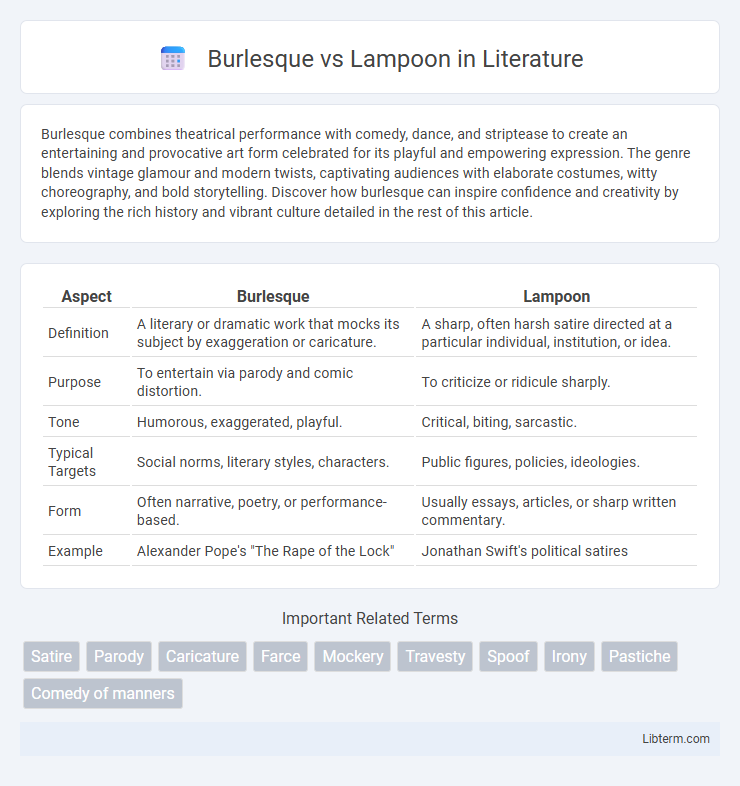Burlesque combines theatrical performance with comedy, dance, and striptease to create an entertaining and provocative art form celebrated for its playful and empowering expression. The genre blends vintage glamour and modern twists, captivating audiences with elaborate costumes, witty choreography, and bold storytelling. Discover how burlesque can inspire confidence and creativity by exploring the rich history and vibrant culture detailed in the rest of this article.
Table of Comparison
| Aspect | Burlesque | Lampoon |
|---|---|---|
| Definition | A literary or dramatic work that mocks its subject by exaggeration or caricature. | A sharp, often harsh satire directed at a particular individual, institution, or idea. |
| Purpose | To entertain via parody and comic distortion. | To criticize or ridicule sharply. |
| Tone | Humorous, exaggerated, playful. | Critical, biting, sarcastic. |
| Typical Targets | Social norms, literary styles, characters. | Public figures, policies, ideologies. |
| Form | Often narrative, poetry, or performance-based. | Usually essays, articles, or sharp written commentary. |
| Example | Alexander Pope's "The Rape of the Lock" | Jonathan Swift's political satires |
Understanding Burlesque: Definition and Origins
Burlesque is a literary and theatrical form that originated in the 17th century, characterized by its exaggerated imitation of serious works to create humor through parody and satire. It often employs grotesque distortion, irony, and ludicrous treatment of its subjects, aiming to entertain while critiquing social norms or artistic conventions. The term "burlesque" derives from the Italian word "burlesco," meaning to joke or mock, reflecting its roots in comedic mimicry and theatrical performance.
What is a Lampoon? Key Characteristics
A lampoon is a form of satirical writing or speech aimed at sharply criticizing or ridiculing an individual, institution, or social practice through humor, sarcasm, and exaggeration. Key characteristics of a lampoon include biting wit, direct mockery, and often a personal or political target, using irony and hyperbole to expose flaws or absurdities. Unlike burlesque, which employs broad parody and theatrical exaggeration, lampoons focus primarily on pointed social or literary criticism.
Historical Evolution of Burlesque and Lampoon
Burlesque originated in the 17th century as a literary and theatrical form that exaggerated classical works through humor and parody, evolving into a popular stage performance style in 19th-century America characterized by musical comedy and risque entertainment. Lampoon traces back to the late 17th century as a sharp, satirical critique published in print, famously embodied by magazines like *Punch* in the 19th century that employed biting humor to ridicule political and social figures. Both forms matured through adapting to cultural shifts, with burlesque emphasizing physical performance and lampoon thriving in journalistic satire.
Core Differences Between Burlesque and Lampoon
Burlesque and lampoon differ primarily in their approach to humor and target subjects. Burlesque uses exaggerated imitation to mock serious subjects through theatrical performance and parody, often involving music, dance, and satire. Lampoon focuses on sharp, satirical written or spoken criticism aimed at exposing flaws or absurdities in individuals, institutions, or social practices.
Techniques Used in Burlesque
Burlesque uses exaggeration, parody, and comedic mimicry to ridicule serious subjects by distorting their style or content, often employing slapstick, caricature, and ironic tone to provoke laughter. Techniques such as hyperbole, incongruity, and burlesque dialogue are central to creating humorous contrasts between the original subject and its comic representation. Performance elements like exaggerated gestures, costumes, and satirical mimicry further enhance the burlesque effect, differentiating it from the more straightforward ridicule found in lampoon.
Satirical Strategies in Lampoon
Lampoon employs sharp, exaggerated satire to ridicule individuals or societal norms, often using irony and parody to expose flaws and provoke laughter or critical reflection. It targets specific subjects with biting humor and hyperbole, creating a vivid caricature that highlights absurdities. Unlike burlesque, which emphasizes theatrical exaggeration and mimicry for comedic effect, lampoon's satirical strategy centers on pointed social or political commentary through witty and often caustic prose or imagery.
Famous Examples of Burlesque in Literature and Art
Famous examples of burlesque in literature include Alexander Pope's "The Rape of the Lock," which satirizes high society with exaggerated elegance, and Jonathan Swift's "A Modest Proposal," employing burlesque to mock social issues through outrageous suggestions. In art, burlesque appears in the caricatures of Honore Daumier, whose works exaggerate political figures for comic effect, and in the theatrical performances of the 19th-century Victorian music halls, which combined parody with dance and song. These instances showcase burlesque's blend of humor and critique, contrasting with lampoon's sharper, more personal satire.
Iconic Lampoon Works and Their Impact
Iconic lampoon works such as "National Lampoon's Animal House" and "The National Lampoon Radio Hour" have significantly influenced American comedy by pioneering satirical and irreverent humor that challenged societal norms. These works utilize sharp wit and parody to critique politics, culture, and social conventions, shaping the landscape of modern satire. The enduring popularity of lampoon has cemented its role as a powerful tool for social commentary and entertainment.
Cultural Influence: Burlesque vs Lampoon
Burlesque and lampoon both serve as forms of cultural critique but differ in style and impact; burlesque utilizes theatrical exaggeration and parody to challenge social norms, while lampoon employs sharp satire and ridicule to expose political or societal flaws. Burlesque has historically influenced popular entertainment through its blend of humor and dance, shaping perceptions of performance art and gender roles. Lampoon's cultural influence lies in its power to provoke public discourse and reform by incisively mocking authority figures and institutions.
Choosing the Right Form: When to Use Burlesque or Lampoon
Choosing between burlesque and lampoon depends on the desired tone and target audience; burlesque employs exaggerated physical comedy and parody to entertain through humor and spectacle, ideal for lighthearted satire. Lampoon utilizes sharp, witty criticism to mock and expose flaws, suitable for pointed social or political commentary. Understanding the context and purpose ensures selecting the appropriate form to maximize impact and engagement.
Burlesque Infographic

 libterm.com
libterm.com